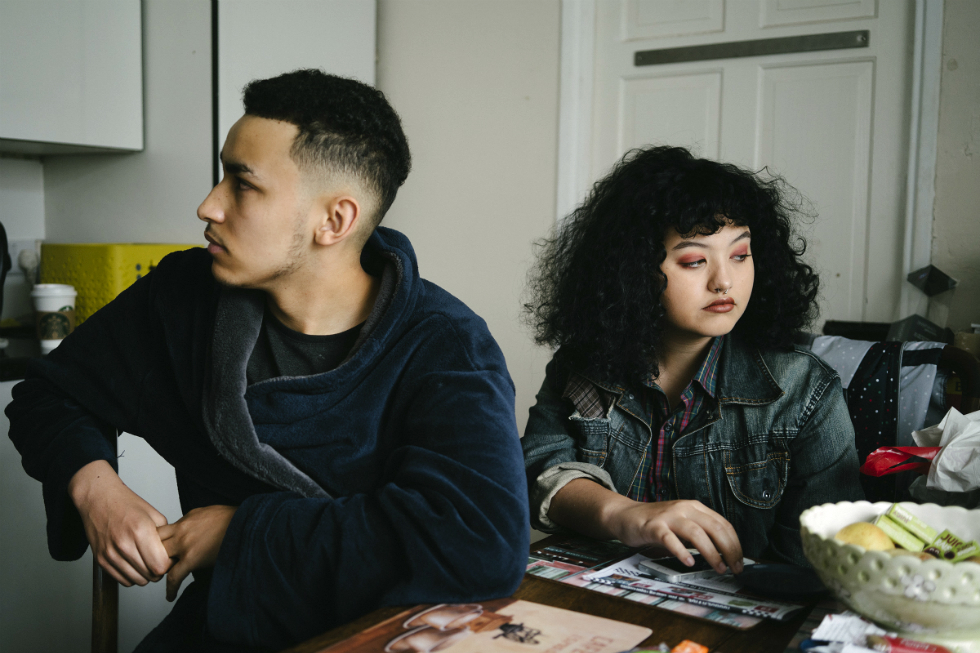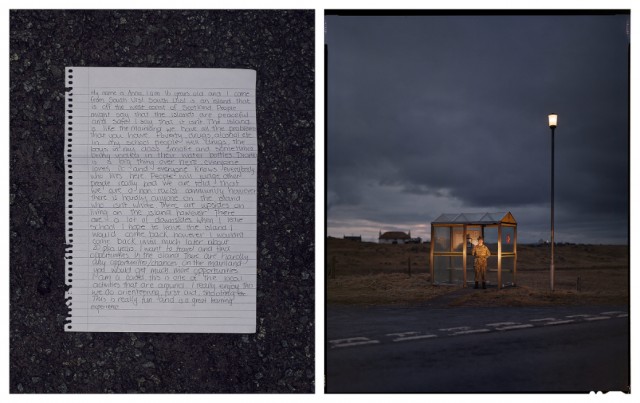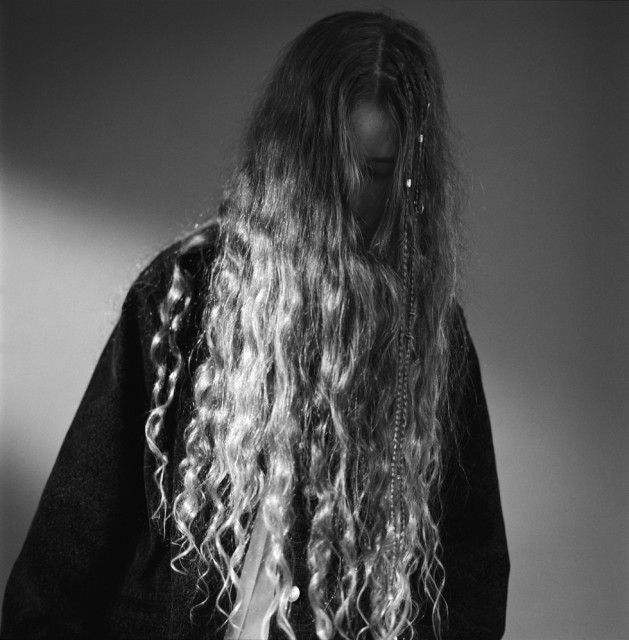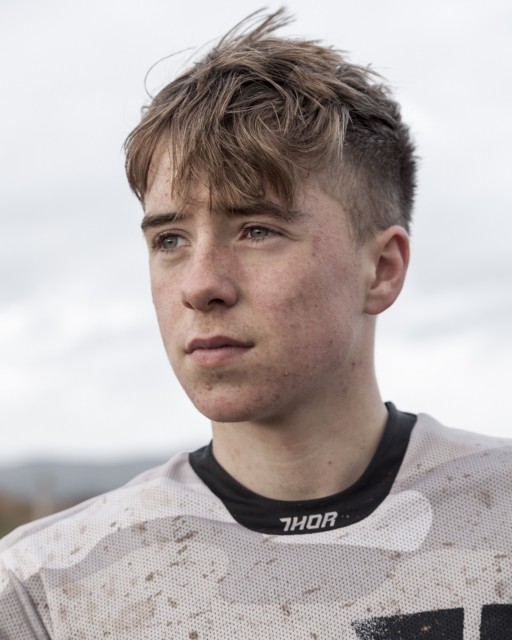Evidence & Empathy – Thoughts on Sixteen

What does it mean to be sixteen now? Joshua Turner explores a photographic project looking to get to the very root of that question…
Portraiture is a mysterious pursuit. In Sixteen, a photographic project by a collection of photographers spearheaded by Craig Easton, this takes the form of representing people who are sixteen years of age. A collaboration embracing individuality in both participating subjects and photographic methods, creating a poetic survey exploring the vast notion of perspective and identity.
In the safety of a gallery we may observe an individual; vacant are the social norms of acknowledgment and interaction, for each subject is frozen in time, unresponsive to our gaze. It is here that the mimetic language of photography can negate the awkwardness of subtle observation in an ordinary setting. A curiosity that persists to know more, whilst social compliance highlights this as a rude gesture. To observe without such constraints is a rare opportunity, gazing into the eyes of a stranger, scrutinising their presentation in search of clues as to who they could be. The staging of a portrait shares similarities with sculpture; working with the pliability of a material, or in this case character, moulding their presentation. An individual’s core values can influence the process of forming their visualised identity, but such intricacies may be obscured through interpretation, both by the photographer and viewer respectively. It is through the fragments of character which we must build a perception of identity, for a portrait is far from a direct representation of an individual.
Illuminated by a passing car we see a lone figure standing sentry, their stance strong and proud, no matter if they are observed or not. The subdued lighting around the frame leads to an imaginative construction of narrative as the mind fills in the blanks; enigma that encourages a further mythologisation of the military. They are standing guard at a small outpost before a stronghold further down the road, seen in the distance over their shoulder. I search for the warning signs of a minefield which they must guard, protecting the fortress; scrutinising the yellow signage upon the lamppost and shelter. As my eyes wander around the frame in search of answers, I see Anna is stood in a bus stop. Remembering she is sixteen, the façade I have built suddenly falls, revealing the truth. The reality of the image may not align with my initial perception, but this narrative originates from the physical stoicism that Anna imbues, combined with the visual symbolism of the Combat Uniform. The photograph as an evidential document can be misconstrued and does not always represent a literal truth, but this physical manifestation of a soldier provides a figurative truth, the fortitudinous values Anna will have developed as a cadet will permeate her psyche. Whatever her pursuit may be, she will approach it with the strength and pride that she embodies in this image.

In another portrait (Hector, photographed by Easton), a shed is as much the subject as anything. Its weather-worn yellow door reflects a light hearted nature, of all the colours that could complement the earthen tonality of the surrounding landscape, yellow is used as an expression over necessity. This articulation presents the humour that may ease life and work in the Scottish Isles, a place of beautiful landscapes and harsh climates. Lending further focus to the shed as a projection of the self, wedged above the door are two crossed saws, appropriating the traditional wall décor of a stately manor house of the upper class. The gesture presents a tool that would be displayed immaculately as an appreciation of craft, whilst serving to symbolise status, wealth and tradition. The satirisation of this symbol is manifest through the indexical trace of work upon the tools, two saws with faded grey handles, rusted bolts and blades that are worn from work and weathered by rain. This mimicry offers a comparison of different hierarchical structures, whilst using the literal evidence of a tool that has been worked, used to the point of retirement to signify reality. The reality of the conditions as people work the land, often a mantle passed down through generations. There is a religiosity in this dedication, a sacrifice in accepting a job that will permeate your life. Life where a Border Collie is more than a loyal companion, it is an essential asset. This objectification understates the deep connection between the two, for they must work together in the land. Hector gazes into the camera with a bemused smirk, a reaction to being photographed, an indication of his humour. As he relaxes into the process, his Collie continues to search their surroundings with a vigilance that they can both rely on.
A portrait can come in various forms, the photographic form is the easiest to acknowledge through the recognition of an individual. Hand-written text is a form of portrait that is less identifiable, yet it provides a deeper level of insight which a photograph can only infer. The literary expression conveys a sense of emotion through pacing and structure, inconsistencies are indicative of passion, where the excitement of a narrative strung together in thought is too fast for the hand to transcribe. This autobiographical text is a transcript of internal monologue, access to which is extremely limited, especially within the bounds of image-making.
Linda Brownlee’s portrait of another Anna feels claustrophobic as her form is entombed within a mass of hair, a shield from the viewer’s gaze. Anna’s poetic reflection feels intuitive, responding with fluidity on a page unbound by lines. In the written piece there is a relationship between the autobiographical and culturally referential, intertwined through an ambiguity that is reflected in her picture. Anna presents herself, but certainly with contextual qualifiers. This image may not offer any cultural evidence, but it provides an insight into the emotional expression of an individual, reminding us of the intangibility of emotion and the shortcomings of photography.
School is a wide cultural experience, our memories riddled with the dated architecture, favourite subjects or particular individuals. We all likely found intricacies in this childish topography; whether of joy or disdain. The vast space of Stuart Freedman’s portrait of Rebekah is indicative of the otherness that may be felt as she disowns the institutionalism of school through home studies. There is a tension felt between the freedom of the natural and the discomfort of Rebekah’s position as she stands balanced on a pallet; suspended in observation. The freedom of home schooling offers her an advantageous insight into the post-educational world, whilst the separation saves her from the intensity that can become overwhelming. Whether at home or in school, sixteen remains an age of educational crescendo. 12 years of relative comfort through the stability of an institution, literal or figurative, culminates in a heavy anticipation of the future. An age to decide on a career path that could last a lifetime, a tough commitment to make with such sparse experience. Sixteen is a testament to the generational awareness of the social and political climate, through the expression of fear for what might come and hope for individual potential. Their prospective dreams and pursuits present the blueprints for a culturally rich and expressive generation that is not fixed to a single interest but is dynamic in the manifestation of their ambition.

The focus on individuality throughout the series presents a study of how this generation encounters life. It’s a joy to celebrate, and yet there feels as if something is missing, an oversight in what forms part of the foundation of our contemporary reality. I see no glare of a screen or incessant digital click of a faux-physical keyboard. Sixteen draws parallels to the surreal banality of the dated sit-com, a dramatisation of a reality now in the past, presenting a recent history in which the sole use of a phone was to make a call, anchored to a wall. This lack of mobile devices isn’t a misrepresentation of reality, it presents the ideology of someone who has not experienced such an intense digital incubation. It is not necessarily important to include mobile phones within these images, but it is their thorough exclusion that is indicative of the generation gap between subject and photographer. To have a mobile device as a defining feature within a portrait may devalue the subject; showing too much attention to a phone is a cultural stigma, indicating a dismissal of the present. The formal process of making a portrait, especially with a view camera, is to have a hyperawareness of and focus on the here and now; the stigma that surrounds the use of a mobile in formal situations perhaps causes too much anxiety to have it feature in an image. There seems to be a unanimous understanding of the appropriate time to use a phone, yet as new generations emerge, the accepted norms may begin to warp as technology becomes an integral instrument in communication.
Social media is visually saturated with imagery in response to social hierarchy that revolves around a representation of the self. This commodification of personality is measured quantitatively and clearly presents a judgement of placement within the social structure. The role of the photographer in this context is to curate a survey of this generation and present them in a way that provokes an emotional response. This inadvertently dismisses the negative aspects of social media, encouraging people to take a break from the social stock market and appreciate experiences for their true value; simply having experienced it. The age of sixteen serves as a cultural milestone, a significant period that people can both look towards in wonder and look back upon in contemplation. The photographer navigates the social climate, focussing on celebrating the individuality of life, the intricacy of emotion and the excitement of experience.
Interpretation of this project is accessibly layered. Whilst some may enjoy deciphering the symbols and signs, others will prefer the feeling of having shared someone’s story. In this poetic survey there is no presentation of statistics or expectation of a conclusion, it invites us to observe and contemplate. It provides an opportunity to ponder on the experienced, acknowledging memories that may have long since been disregarded. Empathy adds another dimension, as the viewer contemplates their own experience as a sixteen-year-old. The evidence within the imagery can say a lot about the subject, as I have explored in previous paragraphs, but I think the honesty of this project comes from empathetic tendencies of the audience.

Once I had gazed at the portrait of Scott, photographed by David Copeland, my eyes settled on the text upon the front of his collar. The same motorcycle apparel brand that I had once worn, when I was a little younger than Scott. Not a shirt but a pair of gloves. Gloves that were too tight, restricting my fingers from straightening. The seams inside the forefingers protruded too much, causing discomfort with use of the clutch; whilst the outside of the seams were presented immaculately. Not quite covering my wrist, exposing my arm to a chill on the days when the wind was blowing, and the rain was falling. The only heat was provided by the steaming front exhaust pipe, grasped with one gloved hand to transfer the heat to the opposite wrist, savouring the warmth. Scott’s discoloured cheek shows the toil of the day, the mud and grime built up from dirt and dust. Kicked up by wheels digging ruts, searching for the best lines to navigate the terrain. A helmet removed to take a break, the wind blowing upon the side of a hill messes with your hair; no matter. After eyeing the route again your hair is pushed out of your face and the helmet is fitted, adjusted slightly for comfort before securing the chin strap and kicking the bike to life; the 125cc engine being the soul of your closest companion for the day.
Scott’s portrait brought me to tears in the exhibition. I was not prepared to be faced with vivid memories of my past. This image gave me the opportunity to recall some of my favourite memories, which otherwise would have been neglected for longer than I care to admit. The hours I spent as a teenager honing my skills and competing with friends. I can only imagine how others may have responded, how the imagery provided a vehicle, resurrecting a distant memory.
Portraiture presents the fundamental connection we have with fellow human beings, the universal language of emotion enabling empathy through the mutual experience of life. The social, cultural and individual landscapes are so vast and intricate that we cannot begin to understand each individual fully, but to take the time to acknowledge someone’s life is to show a respect to this untameable notion. The portraiture of the Sixteen project enables a platform on which we can practice this respect and observe the diversity of a generation. If observation is all we can muster, then this is enough. Yet if we’re fortunate, there may be at least a single image that strikes our soul, that reaches into our being and grasps at distant memories that lay dormant. It is then that we can truly connect with someone in a photograph, a stranger from another county or country, with which we share an emotional connection. A connection which, in my case, was a reminder of ill-fitting gloves and the methods of warming my cold wrists. The fleeting moments are just as valuable as the memorable, providing the intricacies of what it means to be alive.
Joshua Turner
Joshua Turner saw Sixteen at Format Festival, in Salford and at Home Manchester. The exhibition continues to tour in venues across the UK
Images from top (subject in brackets): Chris Nunn (Carlton & Dominique); Craig Easton (Anna); Linda Brownlee (Anna); David Copeland (Scott)





